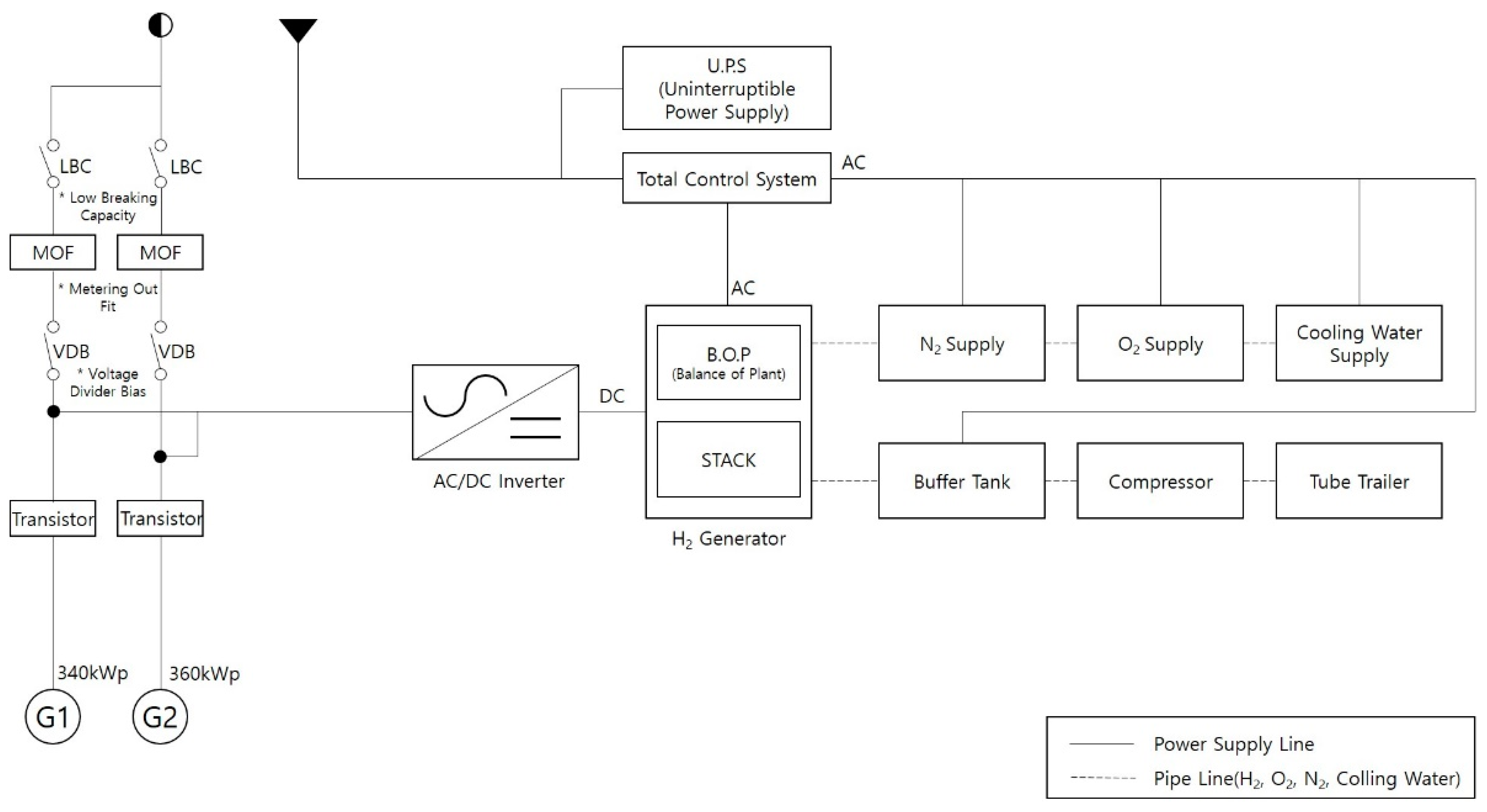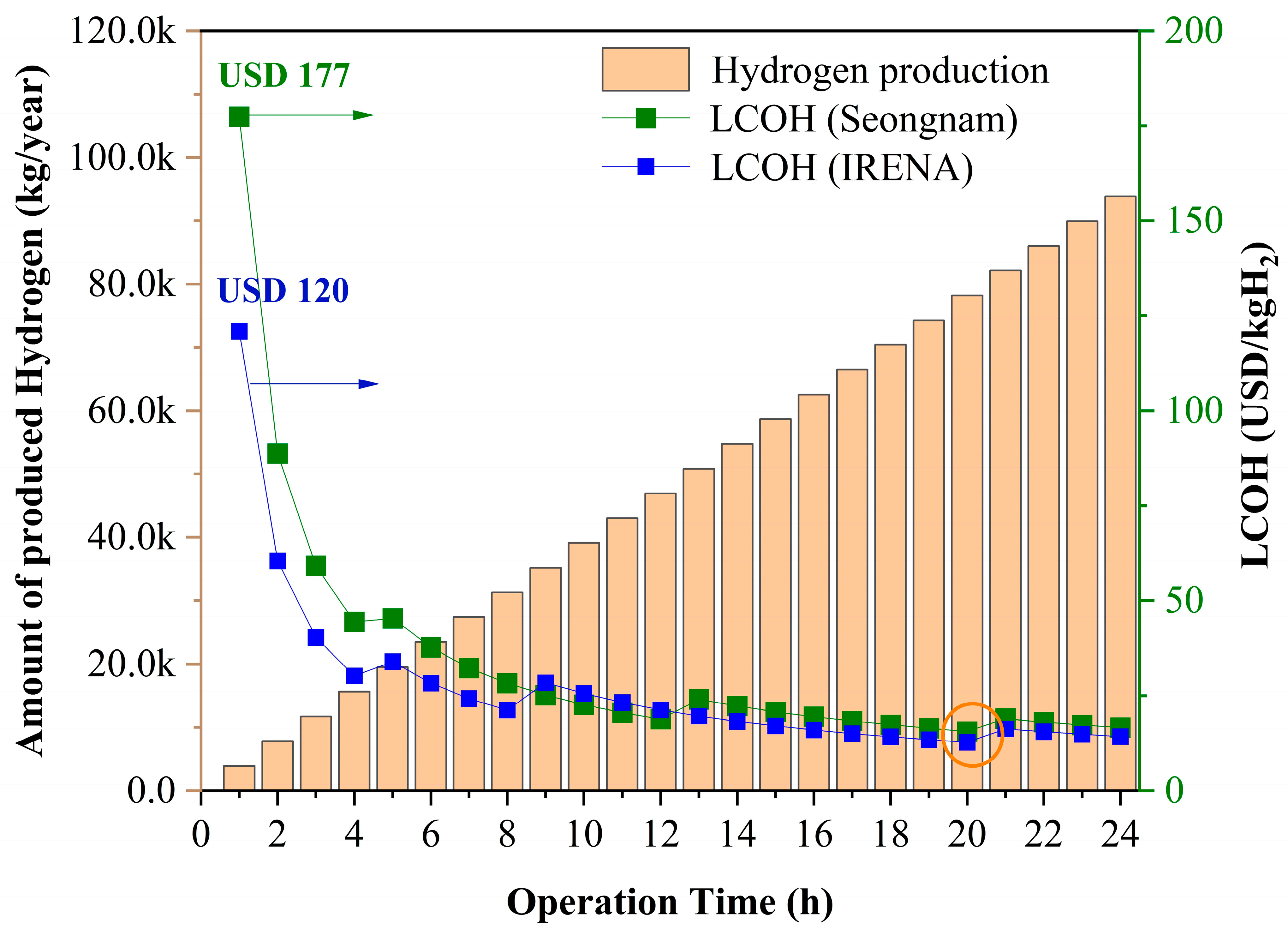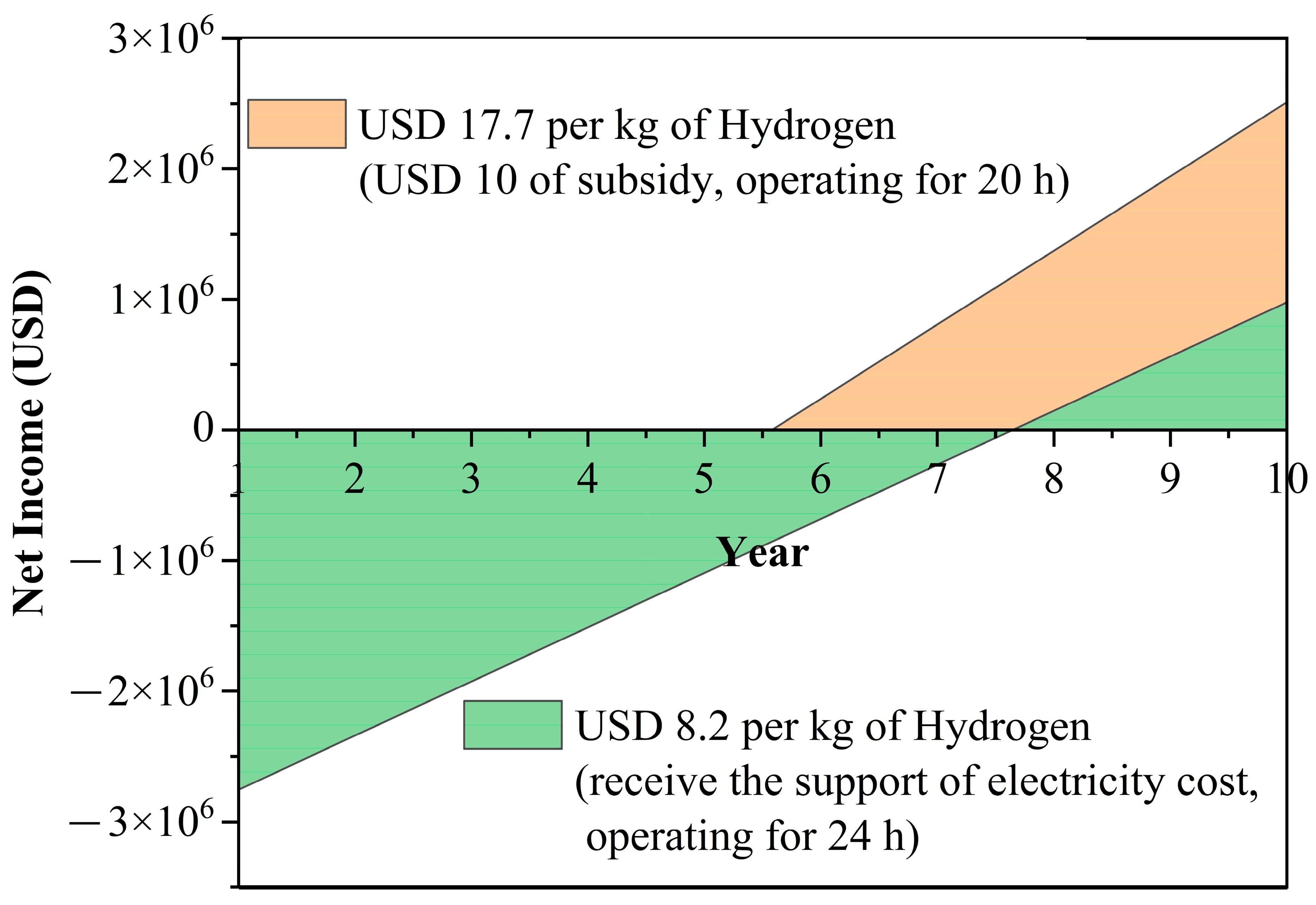Design and Optimization of an Alkaline Electrolysis System for Small-Scale Hydropower Integration
Abstract
:1. Introduction
2. Materials and Methods
3. Results and Discussion
3.1. Small-Scale Hydropower Analysis
3.2. Experimental Facility Configuration and Evaluation
3.3. Economic Evaluation and Analysis
4. Conclusions
Author Contributions
Funding
Data Availability Statement
Conflicts of Interest
References
- Sdanghi, G.; Maranzana, G.; Celzard, A.; Fierro, V. Review of the current technologies and performances of hydrogen compression for stationary and automotive applications. Renew. Sustain. Energy Rev. 2019, 102, 150–170. [Google Scholar] [CrossRef]
- Yuki, I.; Mari, V.; Petter, N.; Simon, R.; David, B.; Stefania, G. Large-scale production and transport of hydrogen from Norway to Europe and Japan: Value chain analysis and comparison of liquid hydrogen and ammonia as energy carriers. Int. J. Hydrog. Energy 2020, 45, 32865–32883. [Google Scholar] [CrossRef]
- Çelik, D.; Yıldız, M. Investigation of hydrogen production methods in accordance with green chemistry principles. Int. J. Hydrog. Energy 2017, 42, 23395–23401. [Google Scholar] [CrossRef]
- Hermesmann, M.; Müller, T.E. Green, turquoise, blue, or grey? Environmentally friendly hydrogen production in transforming energy systems. Prog. Energy Combust. Sci. 2022, 90, 100996. [Google Scholar] [CrossRef]
- Jaszczur, M.; Hassan, Q.; Sameen, A.Z.; Salman, H.M.; Olapade, O.T.; Wieteska, S. Massive green hydrogen production using solar and wind energy: Comparison between europe and the Middle East. Energies 2023, 16, 5445. [Google Scholar] [CrossRef]
- Pareek, A.; Dom, R.; Gupta, J.; Chandran, J.; Adepu, V.; Borse, P.H. Insights into renewable hydrogen energy: Recent advances and prospects. Mater. Sci. Energy Technol. 2020, 3, 319–327. [Google Scholar] [CrossRef]
- Bauer, C.; Treyer, K.; Antonini, C.; Bergerson, J.; Gazzani, M.; Gencer, E.; Van der Spek, M. On the climate impacts of blue hydrogen production. Sustain. Energy Fuels 2022, 6, 66–75. [Google Scholar] [CrossRef]
- Howarth, R.W.; Jacobson, M.Z. How green is blue hydrogen? Energy Sci. Eng. 2021, 9, 1676–1687. [Google Scholar] [CrossRef]
- Yu, M.; Wang, K.; Vredenburg, H. Insights into low-carbon hydrogen production methods: Green, blue and aqua hydrogen. Int. J. Hydrog. Energy 2021, 46, 21261–21273. [Google Scholar] [CrossRef]
- Alberto, B. Renewable hydrogen to recycle CO2 to methanol. Int. J. Hydrog. Energy 2013, 38, 1806–1812. [Google Scholar] [CrossRef]
- Sumit, S.; Om, P.; Mahdi, B.; Jean-Yves, D.; Belkacem, O.B.; Mathieu, B.; Anne-Lise, G. Generic Dynamical Model of PEM Electrolyser under Intermittent Sources. Energies 2020, 13, 6556. [Google Scholar] [CrossRef]
- Gahleitner, G. Hydrogen from renewable electricity. An international review of power-to-gas pilot plants for stationary applications. Int. J. Hydrog. Energy 2013, 38, 2039–2061. [Google Scholar] [CrossRef]
- Hanne, K.; Kristin, J.; Olav, B. A quantitative comparison of gas turbine cycles with CO2 capture. Energy 2007, 32, 10–24. [Google Scholar] [CrossRef]
- Nel, A.S.A. The World’s Most Efficient and Reliable Electrolysers: Nel Hydrogen Electrolysers; Nel ASA: Oslo, Norway, 2021; Volume 4. [Google Scholar]
- Kopp, M.; Coleman, D.; Stiller, C.; Scheffer, K.; Aichinger, J.; Scheppat, B. Energiepark Mainz: Technical and economic analysis of the worldwide largest Power-to-Gas plant with PEM electrolysis. Int. J. Hydrog. Energy 2017, 42, 13311–13320. [Google Scholar] [CrossRef]
- Schmidt, O.; Gambhir, A.; Staffell, I.; Hawkes, A.; Nelson, J.; Few, S. Future cost and performance of water electrolysis: An expert elicitation study. Int. J. Hydrog. Energy 2017, 42, 30470–30492. [Google Scholar] [CrossRef]
- Dincer, I.; Aydin, M.I. New paradigms in sustainable energy systems with hydrogen. Energy Convers. Manag. 2023, 283, 116950. [Google Scholar] [CrossRef]
- Chu, W.; Vicidomini, M.; Calise, F.; Duić, N.; Østergaard, P.A.; Wang, Q.; Da Graça Carvalho, M. Review of Hot Topics in the Sustainable Development of Energy, Water, and Environment Systems Conference in 2022. Energies 2023, 16, 7897. [Google Scholar] [CrossRef]
- Dong-Yeon, L.; Elgowainy, A.; Dai, Q. Life cycle greenhouse gas emissions of hydrogen fuel production from chlor-alkali processes in the United States. Appl. Energy 2018, 217, 467–479. [Google Scholar] [CrossRef]
- Huan, L.; Shuqin, L. Life cycle energy consumption and GHG emissions of hydrogen production from underground coal gasification in comparison with surface coal gasification. Int. J. Hydrog. Energy 2021, 46, 9630–9643. [Google Scholar] [CrossRef]
- Kleijne, K.; De Coninck, H.; Van Zelm, R.; Huijbregts, M.A.; Hanssen, S.V. The many greenhouse gas footprints of green hydrogen. Sustain. Energy Fuels 2022, 6, 4383–4387. [Google Scholar] [CrossRef]
- Kotter, E.; Schneider, L.; Sehnke, F.; Ohnmeiss, K.; Schroer, R. Sensitivities of power-to-gas within an optimised energy system. Energy Procedia 2015, 73, 190–199. [Google Scholar] [CrossRef]
- Jentsch, M.; Trost, T.; Sterner, M. Optimal use of power-to-gas energy storage systems in an 85% renewable energy scenario. Energy Procedia 2014, 46, 254–261. [Google Scholar] [CrossRef]
- Tiina, K.; Henrik, T.; Jukka, K. Economic analysis of hydrogen production by methane thermal decomposition: Comparison to competing technologies. Energy Convers. Manag. 2018, 159, 264–273. [Google Scholar] [CrossRef]
- Walker, S.B.; Mukherjee, U.; Fowler, M.; Elkamel, A. Benchmarking and selection of Power-to-Gas utilizing electrolytic hydrogen as an energy storage alternative. Int. J. Hydrog. Energy 2016, 41, 7717–7731. [Google Scholar] [CrossRef]
- Kafetzis, A.; Bampaou, M.; Kardaras, G.; Panopoulos, K. Decarbonization of Former Lignite Regions with Renewable Hydrogen: The Western Macedonia Case. Energies 2023, 16, 7029. [Google Scholar] [CrossRef]
- Alireza, S.; Mobin, A.; Zhiping, L.; Zongwen, L.; Ali, A. Modelling and sequential simulation of multi-tubular metallic membrane and techno-economics of a hydrogen production process employing thin-layer membrane reactor. Int. J. Hydrog. Energy 2016, 41, 19081–19097. [Google Scholar] [CrossRef]
- Pravin, P.; Felix, W.; Janusz, B. Smart Operation of Smart Grid: Risk-Limiting Dispatch; IEEE: Piscataway, NJ, USA, 2011; Volume 99, pp. 40–57. [Google Scholar] [CrossRef]
- Anita, K.S.; Athena, K.S. Wind-hydrogen utilization for methanol production: An economy assessment in Iran. Renew. Sustain. Energy Rev. 2011, 15, 3570–3574. [Google Scholar] [CrossRef]
- Patiño, J.J.; Velásquez, C.; Ramirez, E.; Betancur, R.; Montoya, J.F.; Chica, E.; Jaramillo, F. Renewable Energy Sources for Green Hydrogen Generation in Colombia and Applicable Case of Studies. Energies 2023, 16, 7809. [Google Scholar] [CrossRef]
- Palmer, G.; Roberts, A.; Hoadley, A.; Dargaville, R.; Honnery, D. Life-cycle greenhouse gas emissions and net energy assessment of large-scale hydrogen production via electrolysis and solar PV. Energy Environ. Sci. 2021, 14, 5113–5131. [Google Scholar] [CrossRef]
- Tzoraki, O. Operating small hydropower plants in Greece under intermittent flow uncertainty: The case of Tsiknias river (Lesvos). Challenges 2020, 11, 17. [Google Scholar] [CrossRef]
- Jung, J.; Jung, S.; Lee, J.; Lee, M.; Kim, H.S. Analysis of small hydropower generation potential:(2) future prospect of the potential under climate change. Energies 2021, 14, 3001. [Google Scholar] [CrossRef]
- Huangpeng, Q.; Huang, W.; Gholinia, F. Forecast of the hydropower generation under influence of climate change based on RCPs and Developed Crow Search Optimization Algorithm. Energy Rep. 2021, 7, 385–397. [Google Scholar] [CrossRef]
- Shu, J.; Qu, J.J.; Motha, R.; Xu, J.C.; Dong, D.F. Impacts of climate change on hydropower development and sustainability: A review. In IOP conference series: Earth and environmental science. IOP Publ. 2018, 163, 12126. [Google Scholar] [CrossRef]
- Amougou, C.B.; Tsuanyo, D.; Fioriti, D.; Kenfack, J.; Aziz, A.; Elé Abiama, P. LCOE-Based Optimization for the Design of Small Run-of-River Hydropower Plants. Energies 2022, 15, 7507. [Google Scholar] [CrossRef]
- Skoulikaris, C.; Kasimis, K. Investigation of climate change impacts on hydropower generation: The case of a run-of-river small hydropower plant in North Western Greece. In IOP Conference Series: Earth and Environmental Science; IOP Publishing: Bristol, UK, 2021; Volume 899, pp. 12026–12035. [Google Scholar] [CrossRef]
- Bailera, M.; Lisbona, P.; Romeo, L.M.; Espatolero, S. Power to Gas projects review. Lab, pilot and demo plants for storing renewable energy and CO2. Renew. Sustain. Energy Rev. 2017, 69, 292–312. [Google Scholar] [CrossRef]
- Parra, D.; Patel, M.K. Techno-economic implications of the electrolyser technology and size for power-to-gas systems. Int. J. Hydrog. Energy 2016, 41, 3748–3761. [Google Scholar] [CrossRef]
- Gotz, M.; Lefebvre, J.; Mors, F.; McDaniel Koch, A.; Graf, F.; Bajohr, S. Renewable Power-to-Gas. A technological and economic review. Renew. Energy 2016, 85, 1371–1390. [Google Scholar] [CrossRef]
- Varone, A.; Ferrari, M. Power to liquid and power to gas. An option for the German Energiewende. Rev. Enew Sustain. Energy Rev. 2015, 45, 207–218. [Google Scholar] [CrossRef]
- Wolf-Peter, S. Residual load, renewable surplus generation and storage requirements in Germany. Energy Policy 2014, 73, 65–79. [Google Scholar] [CrossRef]
- Alfredo, U.; Luis, M.; Gandı, P.S. Hydrogen Production from Water Electrolysis: Current Status and Future Trends; IEEE: Piscataway, NJ, USA, 2012; Volume 100, pp. 410–426. [Google Scholar] [CrossRef]
- Domenico, F.; Martina, G.; Andrea, L.; Massimo, S. Power-to-Gas Hydrogen: Techno-economic assessment of processes towards a multi-purpose energy carrier. Energy Procedia 2016, 101, 50–57. [Google Scholar]
- Sebastian, S.; Thomas, G.; Martin, R.; Vanessa, T.; Bhunesh, K.; Detlef, S. Power to gas: Technological overview, systems analysis and economic assessment for a case study in Germany. Int. J. Hydrog. Energy 2015, 40, 4285–4294. [Google Scholar] [CrossRef]
- Boreum, L.; Heetae, C.; Nak Heon, C.; Changhwan, M.; Sangbong, M.; Hankwon, L. Economic evaluation with sensitivity and profitability analysis for hydrogen production from water electrolysis in Korea. Int. J. Hydrog. Energy 2017, 42, 6462–6471. [Google Scholar] [CrossRef]
- Walker, S.B.; Van Lanen, D.; Fowler, M.; Mukherjee, U. Economic analysis with respect to Power-to-Gas energy storage with consideration of various market mechanisms. Int. J. Hydrog. Energy 2016, 41, 7754–7765. [Google Scholar] [CrossRef]
- Vandewalle, J.; Bruninx, K.; D’haeseleer, W. Effects of largescale power to gas conversion on the power, gas and carbon sectors and their interactions. Energy Convers. Manag. 2015, 94, 28–39. [Google Scholar] [CrossRef]
- Gerda, R.; Johannes, L. Evaluating CO2 sources for power-to-gas applications—A case study for Austria. J. CO2 Util. 2015, 10, 40–49. [Google Scholar] [CrossRef]
- Breyer, C.; Tsupari, E.; Tikka, V.; Vainikka, P. Power-to-Gas as an emerging profitable business through creating an integrated value chain. Energy Procedia 2015, 73, 182–189. [Google Scholar] [CrossRef]
- Yang, Z.; Pietro, C.; Anders, L.; Jinyue, Y. Comparative study of hydrogen storage and battery storage in grid connected photovoltaic system: Storage sizing and rule-based operation. Appl. Energy 2017, 201, 397–411. [Google Scholar] [CrossRef]
- Tosneem, A.S.A.A. ‘Renewable’ hydrogen: Prospects and Challenges. Renew. Sustain. Energy Rev. 2011, 15, 3034–3040. [Google Scholar] [CrossRef]
- Bongjin, G.; Wang, L.Y.; Dongjoo, S. Analysis of the economy of scale for domestic steam methane reforming hydrogen refueling stations utilizing the scale factor. J. Hydrog. New Energy 2019, 30, 251–259. [Google Scholar] [CrossRef]
- Ehlers, J.C.; Feidenhans’l, A.A.; Therkildsen, K.T.; Larrazábal, G.O. Affordable Green Hydrogen from Alkaline Water Electrolysis: Key Research Needs from an Industrial Perspective. ACS Energy Lett. 2023, 8, 1502–1509. [Google Scholar] [CrossRef]
- Bayazıt, Y. The effect of hydroelectric power plants on the carbon emission: An example of Gokcekaya dam, Turkey. Renew. Energy 2021, 170, 181–187. [Google Scholar] [CrossRef]
- Muller, M. Dams have the power to slow climate change. Nature 2019, 566, 315–317. [Google Scholar] [CrossRef] [PubMed]
- Herath, I.; Deurer, M.; Horne, D.; Singh, R.; Clothier, B. The water footprint of hydroelectricity: A methodological comparison from a case study in New Zealand. J. Clean. Prod. 2011, 19, 1582–1589. [Google Scholar] [CrossRef]
- Muñoz Díaz, M.T.; Chávez Oróstica, H.; Guajardo, J. Economic Analysis: Green Hydrogen Production Systems. Processes 2023, 11, 1390. [Google Scholar] [CrossRef]
- Spazzafumo, G.; Raimondi, G. Economic assessment of hydrogen production in a Renewable Energy Community in Italy. e-Prime—Adv. Electr. Eng. Electron. Energy 2023, 4, 100131. [Google Scholar] [CrossRef]
- Jang, D.; Kim, J.; Kim, D.; Han, W.B.; Kang, S. Techno-economic analysis and Monte Carlo simulation of green hydrogen production technology through various water electrolysis technologies. Energy Convers. Manag. 2022, 258, 115499. [Google Scholar] [CrossRef]
- Dabar, O.A.; Awaleh, M.O.; Waberi, M.M.; Adan, A.B.I. Wind resource assessment and techno-economic analysis of wind energy and green hydrogen production in the Republic of Djibouti. Energy Rep. 2022, 8, 8996–9016. [Google Scholar] [CrossRef]
- Superchi, F.; Papi, F.; Mannelli, A.; Balduzzi, F.; Ferro, F.M.; Bianchini, A. Development of a reliable simulation framework for techno-economic analyses on green hydrogen production from wind farms using alkaline electrolyzers. Renew. Energy 2023, 207, 731–742. [Google Scholar] [CrossRef]
- Santana, J.C.C.; Machado, P.G.; Nascimento, C.A.O.D.; Ribeiro, C.D.O. Economic and Environmental Assessment of Hydrogen Production from Brazilian Energy Grid. Energies 2023, 16, 3769. [Google Scholar] [CrossRef]
- Nami, H.; Rizvandi, O.B.; Chatzichristodoulou, C.; Hendriksen, P.V.; Frandsen, H.L. Techno-economic analysis of current and emerging electrolysis technologies for green hydrogen production. Energy Convers. Manag. 2022, 269, 116162. [Google Scholar] [CrossRef]
- Henry, A.; McStay, D.; Rooney, D.; Robertson, P.; Foley, A. Techno-economic analysis to identify the optimal conditions for green hydrogen production. Energy Convers. Manag. 2023, 291, 117230. [Google Scholar] [CrossRef]
- Gerloff, N. Economic analysis of hydrogen production in Germany with a focus on green hydrogen, considering all three major water electrolysis technologies. Sustain. Energy Fuels 2023, 7, 1893–1907. [Google Scholar] [CrossRef]
- Ha, S.; Tae, S.; Kim, R. A study on the limitations of South Korea’s national roadmap for greenhouse gas reduction by 2030 and suggestions for improvement. Sustainability 2019, 11, 3969. [Google Scholar] [CrossRef]
- IRENA. Green Hydrogen Cost Reduction: Scaling Up Electrolysers to Meet the 1.5 °C Climate Goal; International Renewable Energy Agency: Masdar, Abu Dhabi, 2020; pp. 65–66. [Google Scholar]





| Parameter | Value | Unit |
|---|---|---|
| Stack price | 3477 | USD per kWh |
| Stack capacity | 600 | kWh |
| Installation cost | 353,233 | USD |
| Building construction | 730,827 | USD |
| Labor cost | 42,890 (Operating Time: 4 h/day) | USD per year |
| 85,780 (Operating Time: 5–8 h/day) | USD per year | |
| 128,670 (Operating Time: 9–16 h/day) | USD per year | |
| 171,560 (Operating Time: 17–24 h/day) | USD per year | |
| Stack replacement | 45,951 | USD per year |
| Electricity cost | 0.15 | USD per kWh |
| Hydrogen price | 7.33 | USD per kilogram of hydrogen |
| Basis year | 2022 | Year |
| Inflation rate | 4.7 | % |
| Depreciation period | 10 | Year |
| Exchange rate | 1330 | KRW per USD |
| Electricity (Stack) | Electricity (BOP) | Hydrogen (kg/h) | H2 (HHV) | Conversion Factor |
|---|---|---|---|---|
| 600 | 12 | 10.7 | 56 kWh/kg | 70.3% |
Disclaimer/Publisher’s Note: The statements, opinions and data contained in all publications are solely those of the individual author(s) and contributor(s) and not of MDPI and/or the editor(s). MDPI and/or the editor(s) disclaim responsibility for any injury to people or property resulting from any ideas, methods, instructions or products referred to in the content. |
© 2023 by the authors. Licensee MDPI, Basel, Switzerland. This article is an open access article distributed under the terms and conditions of the Creative Commons Attribution (CC BY) license (https://creativecommons.org/licenses/by/4.0/).
Share and Cite
Song, H.; Kim, Y.; Yang, H. Design and Optimization of an Alkaline Electrolysis System for Small-Scale Hydropower Integration. Energies 2024, 17, 20. https://doi.org/10.3390/en17010020
Song H, Kim Y, Yang H. Design and Optimization of an Alkaline Electrolysis System for Small-Scale Hydropower Integration. Energies. 2024; 17(1):20. https://doi.org/10.3390/en17010020
Chicago/Turabian StyleSong, Hojun, Yunji Kim, and Heena Yang. 2024. "Design and Optimization of an Alkaline Electrolysis System for Small-Scale Hydropower Integration" Energies 17, no. 1: 20. https://doi.org/10.3390/en17010020
APA StyleSong, H., Kim, Y., & Yang, H. (2024). Design and Optimization of an Alkaline Electrolysis System for Small-Scale Hydropower Integration. Energies, 17(1), 20. https://doi.org/10.3390/en17010020







